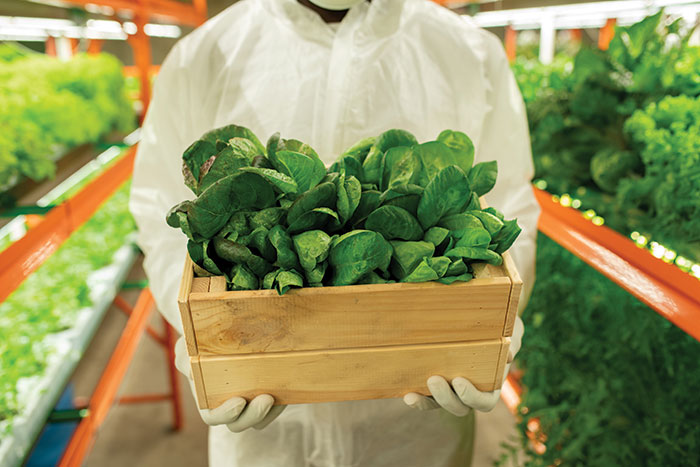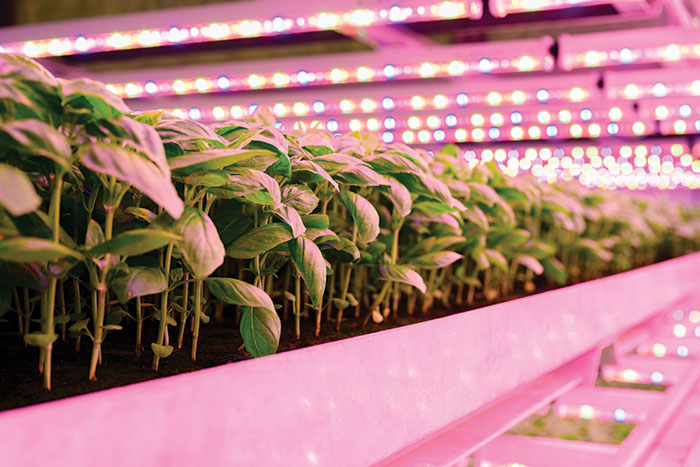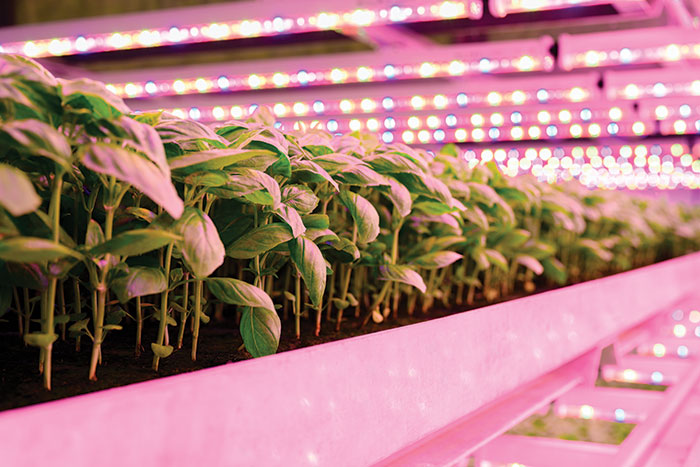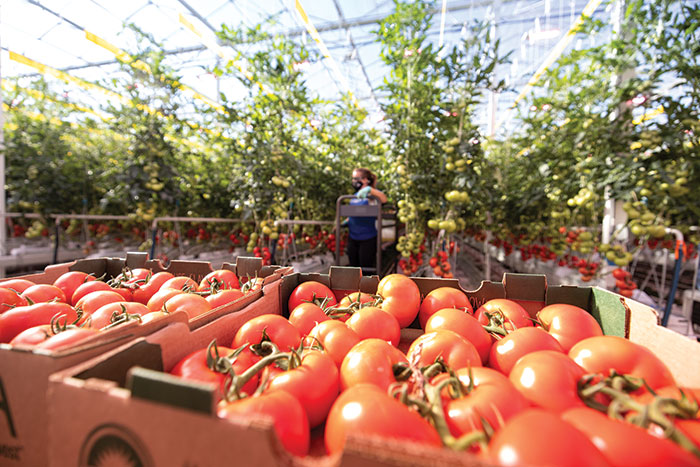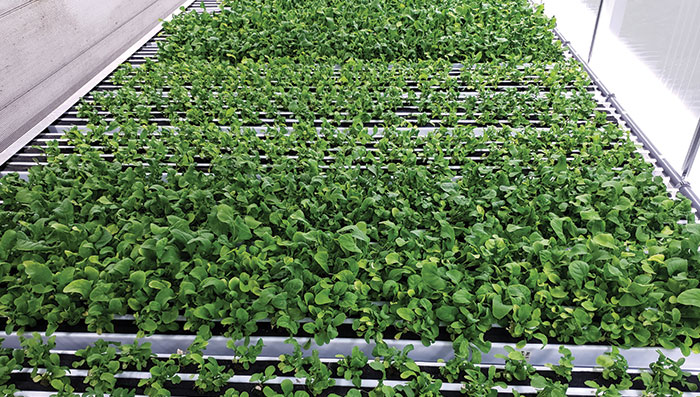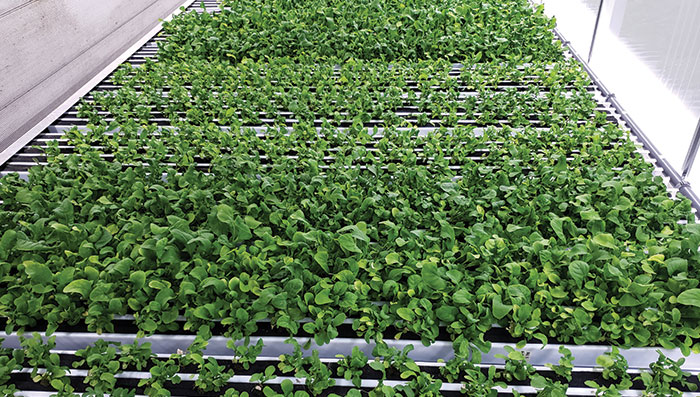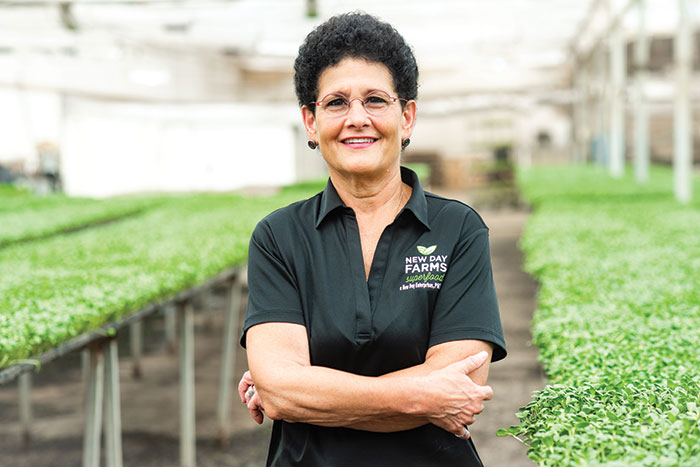
The Bountiful Promise of Indoor Farming
High-tech growing systems are transforming agricultural production, yielding increasingly fruitful harvests in tightly controlled environments.
Article Content
A gleaming vision of the agricultural future has come to the Appalachian hamlet of Morehead, Ky. Several hundred “crop care specialists” in brightly colored T-shirts show up every day at AppHarvest, a low-slung complex of Dutch-style greenhouses that covers three million square feet. They dutifully remove shoots and otherwise tend to 720,000 plants yielding tomatoes, strawberries, and other produce items that never touch the outdoors before they’re harvested and shipped off to Costco, Walmart, and other retail grocery chains in markets all over the country.
Long rows of the plants flank a central walkway in one of the largest buildings in the complex, nudging their way up through small cakes of substrate. Light filtering through the glass roof is refracted and diffused. Water is distributed parsimoniously from the source, a 44 million-gallon retention pond that lies alongside the far end of the building, collecting rain and cycling it through to the plants.
In charge is Jonathan Webb, a personable, baseball cap–wearing former federal bureaucrat who would be great as a children’s television show host if he weren’t an entrepreneur, founder, and CEO of AppHarvest. He’s got another four to five million square feet of greenhouses under construction and plans to boost total employment at AppHarvest to about 1,500 people by year’s end.
“Globally, we’re going to have to move all fruit and vegetable production to a controlled environment like ours,” contends Webb, who founded AppHarvest in 2017. The company attracted $475 million in investments before going public last year, leading to a current valuation of about $1 billion. “Scalability is just a matter of getting it right,” Webb says. “And theoretically, you can grow everything in a controlled environment; it’s just about the economics.”
The economics as well as the optics are looking better and better for indoor agriculture, commonly referred to as CEA or “controlled environment agriculture.” With every report of withering drought and new emergency water conservation measures in California, and with every update on the prolonged monsoon season that washed out crops from rice to dates on the Indian subcontinent this year, the promise of indoor agriculture looms larger. And with every crate of arugula or strawberries that wends its way to a supermarket produce section from a CEA facility, traction increases.
ESG Impacts
“Think about the massive [environmental, social, and governance] play here—droughts, climate change, labor shortages, water shortages, all of these types of things, including food safety and traceability,” says Romie Basra, senior vice president at Wells Fargo and the national clean-tech practice leader for America’s largest agricultural lender.
Already, the United States holds an estimated 40,000 vertical farms of various sizes. CEA investments in the United States were up 77% in 2021 over the previous year, and they have more than tripled since 2019, according to the U.S. Department of Agriculture. The department started a new Office of Urban Agriculture and Innovative Production that made more than $3 million in initial grants in 2020.
There are many more CEA facilities around the world. Dubai just opened the world’s largest vertical farm, for example, which covers more than seven acres and is set to produce more than 900 tons of leafy greens a year, from spinach to arugula.
An estimate by Grand View Research had the industry overall at $40 billion in revenues in 2021, and projections of its size globally by the end of the decade range from about $60 billion to about $155 billion.
Acceptance by retailers and, ultimately, the general public is fueling the trend. Grocers including Walmart, Kroger, and Albertsons are contracting with indoor growers, and Publix added an on-site trailer farm from a local hydroponic grower in the company’s hometown of Lakeland, Fla. A 2021 survey by FMI, The Food Industry Association, found that 43% of shoppers didn’t have a preference for produce coming from indoor versus outdoor farms, and those most likely to prefer indoor sources included members of Generation Z, who are fast becoming America’s most influential demographic cohort.
Indoor agriculture already has a long history. Pioneers in the Netherlands have built the world’s second-largest agricultural export industry, mainly indoors. In the United States, commercial greenhouses have been around for about a century, and vertical farms that stack hydroponically grown plants on top of one another have been proliferating for at least a decade.
The investors in the unprecedented new boom in CEA include Brett Brohl. “The promise of indoor agriculture is that you can grow on-site where the food is needed, so you reduce transportation and logistics costs,” says the head of Bread and Butter Ventures, a venture capital firm in Minneapolis. “You could have a world where you have growing facilities on the roofs of a Target or a restaurant, so you would have no transportation costs.”
But CEA must be suitable to urban and low-water areas to become ubiquitous. Major questions remain about its carbon footprint. Various studies suggest, for instance, that growing a pound of tomatoes in an American greenhouse using fossil fuel energy releases from three to 3.5 pounds of carbon into the atmosphere, about six times the carbon footprint of field tomatoes even after taking transportation emissions into account.
“The hard part is that the most important input is the sun, and in the warehouses and modular farms and vertical farms we have now, you have to replace the sun—which is free outdoors,” Brohl notes. “That tends to make the produce or crop you’re growing more expensive to buy or produce. I don’t think you’ll see mass adoption of indoor-grown crops until cost is at parity.”
And while CEA has made great inroads with greens, herbs, tomatoes, and strawberries, row and tree nut crops still demand the biggest inputs. “For certain crops, in certain climates, it works,” says Patrick Lockwood-Taylor, U.S. president of Bayer, one of the world’s largest fertilizer suppliers. “But it also doesn’t solve the problem of feeding 10 billion people in an ecological way.”
Food safety concerns also lurk even indoors, especially after a Salmonella outbreak in 2021 sickened 31 people in four states and was traced to stored water contamination in a BrightFarms hydroponic greenhouse in Rochelle, Ill.
“The thing that worries me most is complacency,” says Vanessa Coffman, director of the Alliance to Stop Foodborne Illness. “That’s where the industry was prior to [the 2021 outbreak]. They believed CEA was an invincible area because they have control over water and everything and felt they could completely eliminate the risks. But you still have humans involved, and water, and potentially rodents entering your facility.”
Indeed, in many ways, the CEA industry is still taking its own measure. “There is little science-based information about best growing practices, and very little economic data around indoor farming,” says Erik Runkle, a horticulture professor at Michigan State University.
How It’s Being Done
Here’s how three indoor farming enterprises of various sizes and kinds are trying to make the future work today.
• AppHarvest. Webb’s devotion to AppHarvest stems from a career in which he developed a holistic view of the world’s resource challenges. He spent years in the renewable energy sector, including a stint working on a project for the U.S. Department of Defense. He pivoted to indoor agriculture as a way to help mitigate climate change and provide food equity. Webb picked Appalachia for AppHarvest partly because of its ample water supplies and inexpensive electricity and also because Kentucky is his home state.
Already, Webb says, AppHarvest is producing leafy greens and strawberries at competitive prices, and that includes the fact that some farms in Mexico use inexpensive labor to keep costs down for produce they export to the United States. “For the consumer, we’re already at or around the same price,” Webb notes.
The ag tech pioneer is so confident in AppHarvest’s formula that he’s in “conversations with people in Southeast Asia and the Middle East and all over the United States” about establishing CEA farms there. He believes the whole industry is at a tipping point. “Take the 10 things that make it hard for the [outdoor] farmer—they’re getting worse, not better,” he says. Eventually, perhaps, the economics of CEA may allow for under-roof cultivation of nut trees and row crops, Webb says.
• Freight Farms. Jake Felser is another true believer in CEA. “Regenerative agriculture is awesome technology, and we need a spectrum of solutions,” says the chief technology officer of Boston-based Freight Farms, which provides turnkey hydroponic-growing facilities in shipping containers. “But regeneration is very much a mitigation strategy, while CEA is very much an adaptation strategy as the world is changing how we still grow food. We need a plan B if there’s no arable land left.”
Freight Farms sells and ships its containers all over the world, mostly to small-scale farmers who supply produce to grocery stores, restaurants, hospitals, schools, and not-for-profit, community-based organizations such as Boys and Girls Clubs. Over its first decade in business, the company has shipped more than 500 container-based farms around the world.
For about $150,000 plus delivery costs, Freight Farms provides a 320-square-foot, three-dimensional space for hydroponic agriculture that yields a vegetable crop about the equivalent of that from three to five outdoor acres, Felser says. The box is specially insulated and outfitted with an LED lighting system that gives growers a range of wavelengths designed to help plants grow best, from blue light for strong plant stems and foliage to red light for large, leafy plants. A specialized HVAC system keeps humidity and air flow just right. Freight Farms’ proprietary software helps farmers adapt nutrient recipes and growing conditions for different plants.
A Freight Farms container provides at least 8,800 sites for mature plants, plant substrates, and hookups for water, electricity, and the internet. The only thing Freight Farms doesn’t sell are the seeds themselves. Inside the container are a pair of two-sided “grow walls” with vertical channels that provide sites for the plants and deliver water and nutrients from the top of the channels, which wick downward.
“Any excess drains back,” Felser explains. “Most water leaves the farm in the form of plants. A [container] will use about five gallons a day depending on conditions outdoors. That’s 98% more water-efficient than traditional agriculture.”
• New Day. This operation illustrates that within the CEA universe, there are differing philosophies about hydroponic versus soil-based growing. “We grow exclusively in the soil,” says JoAnn Pacinelli, president, CEO, and director of New Day Enterprises, an indoor organic farm in Bealeton, Va., which began as one acre and is expanding rapidly.
“It’s been shown that the nutrient profile of crops grown in soil is much broader than those grown hydroponically,” she says. “You’ve got to have carbon to produce carbon-based compounds. You can put loads of minerals in water, but you can’t do anything much to influence vitamins and other bioactive compounds. Soil is essential because it houses a multitude of microbes, and those microbes are essential to metabolizing and getting into the plant that’s going to be consumed.”
New Day offers 11 different crops, mostly microgreens that it sells to retailers, restaurants, and institutions, as straight SKUs or as blends. Consistent with her personal commitment to “improve the health of the public,” as Pacinelli puts it, the company is focused on species that “in some cases have been used by indigenous and ancient cultures for thousands of years—not just the more trendy things that sit on a retail store shelf.” For example, New Day’s strongest retail crop is sunflower—the leaves, not the seeds.
Support Systems
The rise of CEA has spawned a wide range of suppliers to the growing industry. One of them is Unfold, a two-year-old startup that provides seed and digital solutions exclusively to vertical farms. It was established with $30 million in initial funding from the investment arm of Bayer and from Temasek, a global investment company headquartered in Singapore, a tiny and highly urbanized nation with an intense interest in indoor agriculture.
“We’re looking to create the next generation of value to indoor growers,” says Sonia Lo, the new CEO of Unfold, who recently came to the company with more than a decade of experience in CEA, including helping develop the world’s largest vertical farm.
The challenge and opportunity for Unfold and its clients is illustrated by the evolution of indoor-grown tomatoes, now a primary CEA crop. Two decades ago, only a small percentage of certain types of tomatoes were grown indoors, Lo says, “but as genetics have become a source of competitive advantage, and reliability has been proven with those genetics, now almost all snacking tomatoes are grown indoors for the North American market. This is the same for cocktail and tomatoes on the vine.” The problem is that even today’s genetically refined tomatoes all still require high ceilings when grown indoors, and most indoor farms spread horizontally and use stacked shelving that doesn’t climb 20 or more feet into the air and has shelf height of a foot or so.
Investment in infrastructure to enable precision indoor agriculture is another area leading the industry. “A lot of companies are investing in physical automation,” says Bryan Fried, CEO of Pangea Global Technologies, a technology solutions provider and maker of LED lighting. “They’re concentrating on how to grow key aspects, including light cycles, carbon dioxide, soil acidity, and moisture—the things that make plants grow to maximum yield or not. Also they’re working on automated picking and internal transport of goods. That combination is what the future will require.”
Pangea’s open-architecture, wireless software platform collects all sorts of plant-growth data, including temperature, humidity, and soil content, and automates actions such as watering, turning off lights, and creating alerts. Its capabilities have been refined to, for instance, automatically close the air-conditioning dampers on 20 vertical farms in Arizona as a dust storm approaches.
Expansion Opportunities
Contain is a financial-technology startup that provides funding specifically for indoor agriculture plays. “So many startups out there that are trying to build the next style vertical farm or robot or the next automated system for indoor farms, or watering technologies, have had a hard time with financing,” says Brohl, whose venture capital firm has invested in Contain. “It’s hard to pick winners in indoor ag right now, but there’s a real world in which it’s occurring, and Contain can finance that all.”
Many players believe the world will end up with a CEA footprint fractured regionally and by population concentrations. “There’s already a lot of good market share in the Northeast where access to fresh leafy greens and new categories like strawberries are limited,” Basra says. “You’re going to see it in a lot of colder weather climates where folks are going to want the fresh product. But you won’t see much in Kansas, where field-grown will still be very attractive. And in California, where most of the fruits and vegetables are grown, it’s not going to be economical.”
Boosters often point to urban CEA as the most promising rationale for expanding the industry, with the goal of growing as much produce as possible close to major cities to cut transportation costs and ensure freshness to the majority of the U.S. population who live in them.
“Cites are the single biggest white space” for CEA, Lo says, “but I’m not sure there is a single specific solution that works today in an urban environment. Energy costs in city centers are challenging to optimize, and their footprints tend to be small. Those farms will bear an inordinate labor burden and will be paying very high rent.”
But Unfold, for example, is working on supporting these urban farms, understanding that a change in genetics will be as key as a “fundamental transformation” of their energy and labor infrastructure, Lo says, including ways to build vertical farming with dedicated green energy into cities’ master plans.
It will take a lot more innovation and dedication by players across the CEA landscape to overcome the industry’s challenges and realize the full potential of indoor agriculture. But a lot of people are working on it.
Key Takeaways
- The range of crops cultivated indoors includes greens, tomatoes, strawberries, and more.
- Investments in indoor agriculture in the United States have more than tripled since 2019.
- Although proponents tout its sustainability benefits, questions remain about the carbon footprint of indoor growing.
- A broad range of suppliers to the industry has emerged, including providers of software monitoring programs and lighting systems.


